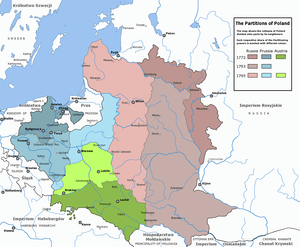Prussian Partition
The Prussian Partition (Polish: Zabór pruski), or Prussian Poland, refers to the former territories of the Polish–Lithuanian Commonwealth acquired during the Partitions of Poland, in the late 18th century by the Kingdom of Prussia.[1] The Prussian acquisition amounted to 141,400 km2 (54,600 sq mi) of land constituting formerly western territory of the Commonwealth. The first partitioning led by imperial Russia with Prussian participation took place in 1772; the second in 1793, and the third in 1795, resulting in Poland's elimination as a state for the next 123 years.[2]
| The Prussian Partition | |
|---|---|
| The Commonwealth | |
The Polish–Lithuanian Commonwealth in 1772 | |
| Elimination | |
 The three partitions of the Polish–Lithuanian Commonwealth. The Russian Partition (red), the Austrian Partition (green), and the Prussian Partition (blue) |
History
The Kingdom of Prussia acquired Polish territories in all three military partitions.[1]
Major historical events of the Prussian Partition included the 1772 annexation of the formerly Polish Prussia by Frederick II who quickly implanted 57,475 German families there in order to solidify his new acquisitions.[3] The Polish language was marginalized.[4] In 1793, the Kingdom of Prussia annexed Gdańsk (Danzig) and Toruń (Thorn), part of the Crown of Poland since 1457. The incursion sparked the first Greater Poland Uprising in Kujawy under Jan Henryk Dąbrowski. The revolt ended after General Tadeusz Kościuszko was captured by the Russians. The subsequent third partitioning of 1795 marked the Prussian annexation of Podlasie region, with the remainder of Masovia, and the capital city of Warsaw (handed over to the Russians twenty years later by Frederick III).[5]


The second Greater Poland Uprising against Prussian forces (also under General Dąbrowski) broke out in Wielkopolska (Greater Poland) in 1806, ahead of the Prussian total defeat by Napoleon who created the Duchy of Warsaw in 1807. However, the fall of Napoleon during his Russian Campaign lead to the dismantling of the Duchy at the Congress of Vienna (1815) and the return of Prussian control.[1]
The third Greater Poland Uprising under Ludwik Mierosławski occurred in 1846. The Uprising was designed to be part of a general uprising against all three states that had partitioned Poland.[6] Some 254 insurgents were charged with high treason in Berlin. Two years later, during the Spring of Nations, the fourth Polish uprising broke out in and around Poznań in 1846, led by the Polish National Committee. The Prussian army pacified the area and 1,500 Poles were imprisoned in Poznań Citadel. The Uprising showed to Polish insurgents that there was no possibility whatsoever to try to negotiate Polish statehood with the Germans. Only sixty years later, the Greater Poland Uprising (1918–1919) in the Prussian Partition helped Poland regain its freedom in the aftermath of World War I.[4]
Society

Poles in the Prussian partition were subject to extensive Germanization policies (Kulturkampf, Hakata).[7] Frederick the Great brought 300,000 colonists to territories he conquered to facilitate Germanization.[8]
That policy, however, had an opposite effect to that which the German leadership had expected: instead of becoming assimilated, the Polish minority in the German Empire became more organized, and its national consciousness grew.[7] Of the Three Partitions, the education system in Prussia was on a higher level than in Austria and Russia, irrespective of its virulent attack on the Polish language specifically, resulting in the Września children strike in 1901–04, leading to persecution and imprisonment for refusing to accept the German textbooks and the German religion lessons.[1][7]
Economy
From the economic perspective, the territories of the Prussian Partition were the most developed, thanks to the overall policies of the government.[7] The German government supported efficient farming, industry, financial institutions and transport.[7]
Administrative division
In the First Partition, Prussia received 36,000 km² and about 600,000 people. In the second partition, Prussia received 58,000 km² and about 1 million people. In the third, similar to the second, Prussia gained 55,000 km² and 1 million people. Overall, Prussia gained about 20 percent of the former Commonwealth territory (149 000 km²) and about 23 percent of the population (2.6 million people).[9] From the geographical perspective, most of the territories annexed by Prussia formed the province of Greater Poland (Wielkopolska).
The Kingdom of Prussia divided the former territories of the Commonwealth it obtained into the following:
- Netze District - from 1772 to 1793
- New Silesia - from 1795 to 1807
- New East Prussia - from 1795 to 1807
- South Prussia - from 1793 to 1806
- East Prussia - from 1773 to 1829
- West Prussia - from 1773 to 1824
Over time the administrative divisions changed. Important Prussian administrative areas set up from Polish lands included:
- Grand Duchy of Posen from 1815–1848
- Province of Posen from 1848–1919
See also
References
- Norman Davies (2005), "Part 3. Preussen: The Prussian Partition", God's Playground. A History of Poland: Volume II: 1795 to the Present, Oxford University Press, pp. 83–101, ISBN 0199253404, retrieved November 24, 2012 Italic or bold markup not allowed in:
|work=(help) - Davies, Norman. God's Playground: a history of Poland. Revised Edition. Oxford: Clarendon Press, 2005.
- Ritter, Gerhard (1974). Frederick the Great: A Historical Profile. Berkeley: University of California Press. pp. 179–180. ISBN 0-520-02775-2.
- Andrzej Chwalba, Historia Polski 1795-1918, Wydawnictwo Literackie 2000, Kraków, pages 175-184, and 307-312. ISBN 830804140X.
- Norman Davies (1996). Europe: a history. Oxford University Press. pp. 828–. ISBN 978-0-19-820171-7. Retrieved February 2, 2011.
- Marian Zagórniak, Józef Buszko, Wielka historia Polski vol. 4 Polska w czasach walk o niepodległość (1815 - 1864). "Od niewoli do niepodległości (1864 - 1918)", 2003, page 186.
- Andrzej Garlicki, Polsko-Gruziński sojusz wojskowy, Polityka: Wydanie Specjalne 2/2008, ISSN 1730-0525, pp. 11–12
- Jerzy Surdykowski, Duch Rzeczypospolitej, 2001 Wydawn. Nauk. PWN, 2001, page 153.
- Piotr Stefan Wandycz, The Price of Freedom: A History of East Central Europe from the Middle Ages to the Present, Routledge (UK), 2001, ISBN 0-415-25491-4, Google Print, p.133
Further reading
- Norman Davies, God's Playground, p. 83-101. PREUSSEN: The Prussian Partition (1772-1918) in Google books preview.